What is Culture Media?
- Culture media are specialized materials that laboratories use to supply essential nutrients and environmental conditions necessary for the growth and propagation of microorganisms. These media play a critical role in microbiology, allowing scientists to culture and study a variety of microbial species under controlled conditions.
- The characteristics, habitats, and nutritional needs of microorganisms vary greatly. As a result, a single kind of culture medium is wholly inadequate for culturing all these organisms. Some microbes, known as obligate parasites, cannot grow in an artificial medium because their specific and intricate nutritional requirements go unmet there Thus, different media preparations are made to fulfill the needs of different organisms.
- Culture media are employed in many scientific fields and in diagnosis of infectious diseases by growing pathogens from clinical samples In addition, cultures from media are used to produce antigens for vaccines, study genetics, and identify organisms. They also make possible the isolation of pure cultures which is essential for observing single microorganisms without contamination.
- Culture media also have numerous other uses. They are for storing culture stocks, examining biochemical reactions, testing microbe pollution, determining effects of antimicrobial agents and preservatives The media are likewise used to measure living microbial counts sensitivity to antibiotics.
- Culture media can be divided into two main types: liquid and gel. Liquid media, often known as broths, permit microorganisms to grow in submerged state gel media, such as agar plates, offer a solid surface on which to make colonies. Both are important auxiliaries to research on microorganisms, each having own specific functions in keeping with experimental requirements.
Definition of Culture Media
Culture media are substances used in laboratories to provide the necessary nutrients and environmental conditions for the growth and maintenance of microorganisms.
Common ingredients of culture media
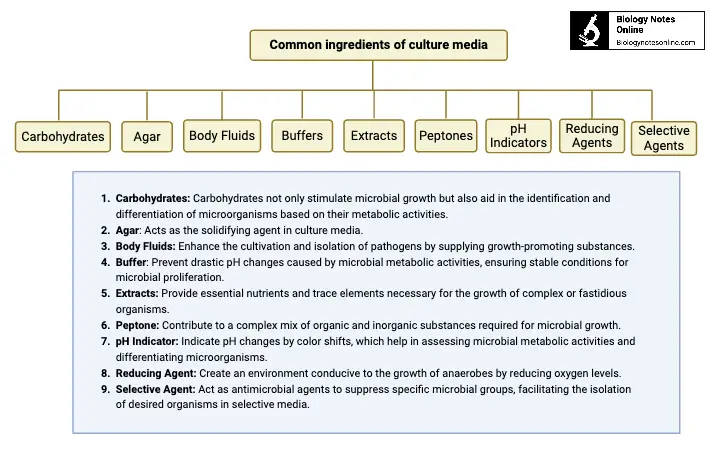
Carohydrates
Carbohydrates, as important sources of energy and carbon, are thus indispensable microbe growth. Such simple sugars as glucose, sucrose and maltose were regularly so treated, Not only do these substances fill microorganisms with vigour for expansion, but they also serve to distinguish species from another by their metabolism products.
Agar
Similarly noteworthy for its gelling power, this product is derived from such algae as Gelidium and Gracilaria. The great melting temperature of 100C and solidifying temperature of 43C means that its ready use is assured Unaffected by incubation temperatures like 37C agar helps to promote the growth of pathogens. Not limited to traditional uses, agarose its purified derivative is used in molecular biology, particularly DNA electrophoresis.
Body Fluids
Materials such as serum, plasma and defibrinated blood are indispensable for many medium formulations. They supply various growth factors as well as neutralizing agents for toxic compounds. This gives the substratum which supports fastidious pathogens not only one way to live but many.
Buffers
Buffers, such as potassium phosphate and calcium carbonate, maintain a constant pH when metabolism is under way. This is especially critical because uncontrolled metabolic lake processes will sharply alter the pH and affect the growth of microorganisms.
Extracts
Extracts derived from yeast, beef liver or brain tissue also provide a variety of nutrients, including amino acids, vitamins and coenzymes. Specially important for complex or exacting organisms needing a wide array of trace elements to grow well are this sort of supply.
Peptones
Peptone as a processing solvent with proteolytic enzymes for example animal muscle tissue to produce hydrolyzates. There are distinctive qualities in the sources: tryptone (casein digest), phytone (soybean digest). The peptides, amino acids and other essential nutrients they produce are capable of supporting diverse microbial cultures.
pH indioators
For observing microbial metabolic activity, pH indicators such as brom-thymol blue or phenol red are employed. These dyes change their colours when the pH shifts, thereby indicating what kind of metabolic products have already been produced. This also helps people tell one kind of microorganism from another.
Reducing Agents
Under anaerobic conditions, compounds such as thioglycollate or cystine lower the redox potential, making it more favorable for the survival and growth of oxygen-sensitive microorganisms.
selective Media
By including agents like bile salts or crystal violet, the selective media can suppress undesirable microbial populations. These are components that target particular groups builds and breeds desired species.
| Ingredient | Role | Examples | Function |
|---|---|---|---|
| Carbohydrates | Provide energy and carbon sources | Glucose, sucrose, maltose | Stimulate growth, aid in microorganism identification and differentiation. |
| Agar | Solidifies the medium | – | Dissolves at ~100°C, solidifies at ~43°C, inert to microbial growth. |
| Body Fluids | Supply growth factors and detoxify inhibitors | Defibrinated blood, plasma, serum | Enhance cultivation of pathogens by providing essential nutrients. |
| Buffers | Maintain optimal pH range | Potassium phosphate, sodium phosphate, calcium carbonate | Prevent pH fluctuations due to microbial metabolism. |
| Extracts | Provide amino acids, vitamins, and coenzymes | Yeast extract, beef brain extract, liver extract | Supply essential nutrients for complex organisms. |
| Peptones | Offer peptides and amino acids | Tryptone, Phytone, general peptone | Provide a wide range of organic and inorganic substances needed for growth. |
| pH Indicators | Monitor pH changes during growth | Brom-thymol blue, phenol red | Indicate pH changes to assess metabolic activities and differentiate organisms. |
| Reducing Agents | Lower oxidation-reduction potential | Cystine, thioglycollate | Support growth of anaerobes by reducing oxygen levels. |
| Selective Agents | Inhibit growth of unwanted microorganisms | Crystal violet, bile salts, sodium azide | Suppress specific microbial groups to allow selective growth of target organisms. |
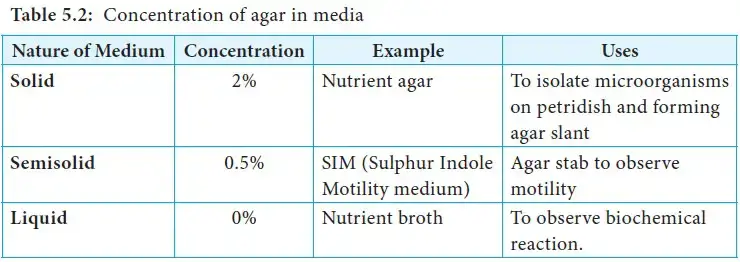

How to prepare culture media?
- Weigh the Ingredients – Carefully measure out each component first. It is very important in precision. Use a balance to weigh out the required amounts, in such a way that the formula matches the type of medium for which you are preparing it.
- Dissolve Ingredients – Combine the dry components with distilled water. Mix it all thoroughly until a standard solution is formed and there are no visible particles left undissolved.
- Adjust pH – Use a pH meter to measure the pH of the solution. If necessary adjust it; acidic or basic substances such as hydrochloric acid or sodium hydroxide can be used for this purpose. An accurate pH value is essential for microbial growth.
- Add Agar (If Needed)– Add agar to the solution. This will act as a solidifying agent. Boil the mixture until the agar has completely dissolved and is a transparent solution.
- Pour into Flasks– Once mixed, pour the medium into sterilization flasks. You should leave some space for expansion during autoclaving; don’t get the flasks too full.
- Autoclave the Medium – Sterilise the medium in an autoclave at 121°C for 15 minutes applying 15 psi pressure. This will effectively wipe out any contaminants that may exist in the culture medium, making it sterile.
- Prepare Sterile Environment– After sterilization, work in a laminar flow cabinet. Use 70% alcohol to clean the cabinet for another experiment. Flasks also need to stay in these sterile conditions before they are used again.
- Cool and Pour– After it has had time to cool enough but remains liquid, pour the medium into sterile Petri dishes. Move quickly so that it does not begin to solidify early on. Plates should be poured uniformly.
- Inoculation– After the medium solidifies, introduce the microbial samples. Tools like an inoculating loop or spreader are used for such operations. This is the beginning work for microbial isolation or study.
- Seal and Incubate– Cover the plates with some sealing material to keep out any contamination. And add labels describing such important details as the type of sample or date of preparation. Incubate the plates upside down at a temperature of 37°C for 24 hours–this is standard practice.
- Observation – After incubation, examine the plates. Typically, visibly some colonies will form that can then be analyzed or used for further experiments as needed.
Classification of Culture Media based on Consistency
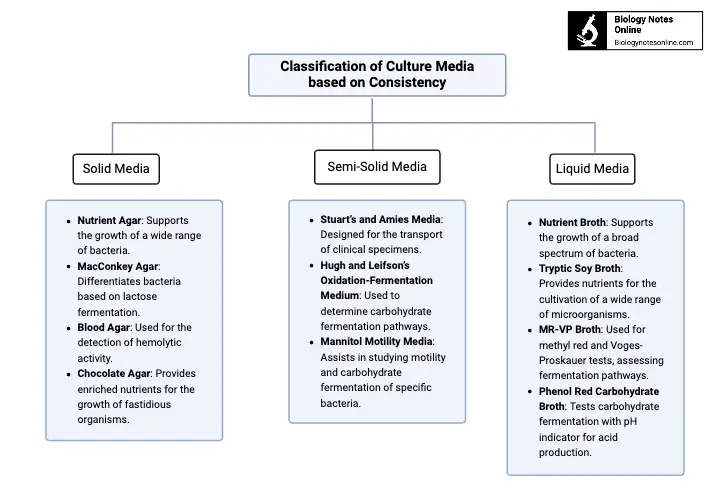
Agar Media
It is extremely important to use agar media in order to avoid contamination from other microorganisms. The medium makes a stable surface where colonies grow tremendously vividly. Agar, the solidifying agent extracted from red algae such as Gelidium, normally contains 1.5–2.0%. It solidifies around 37°C, which helps produce discrete colonies. Examples include:
- Nutrient Agar: Suitable for growth of a variety of species of bacteria.
- MacConkey Agar: Distinguishes bacteria on the basis of lactose fermentation.
- Blood Agar: Shows haemolytic activity.
- Chocolate Agar: Rich in complex nutrients for fastidious organisms.
Colonies come in smooth, rough, mucoid and irregular types, helping identify the organisms involved.
Soft Solid Media
These maintain the softness of jelly by reducing the agar to around 0.5%. It is good for investigative and micro-aerophilic bacteria. The mushy texture allows movements of the microorganisms as well as modes of growth to be revealed. For example:
- Stuart’s and Amies Media: Used to carry clinical specimens.
- Hugh and Leifson’s Medium: Shows that a carbohydrate is being oxidized or fermented.
- Mannitol Motility Medium: Detects motion and fermentation of some bacteria.
Motile organisms move away from the point of introduction, leading to a cloud-like pattern of growth.
Liquid Media
Liquid media also known as broths, contain no solidifying agents like agar. They are good for cultivating large bacterial populations and are commonly used in fermentation research projects. As microorganisms grow, the medium goes cloudy showing that they are indeed proliferating. Typical examples are:
- Nutrient Broth: Supports various microorganisms.
- Tryptic Soy Broth: Has nutrients for growing many kinds of bacteria.
- MR-VP Broth: Tests fermentation pathways.
- Phenol Red Carbohydrate Broth: Shows acid production from breakdown of carbohydrates.
Cloudiness increases as bacterial cells proliferate, showing growth in suspension is underway.
Classification of culture media based on the nutritional component
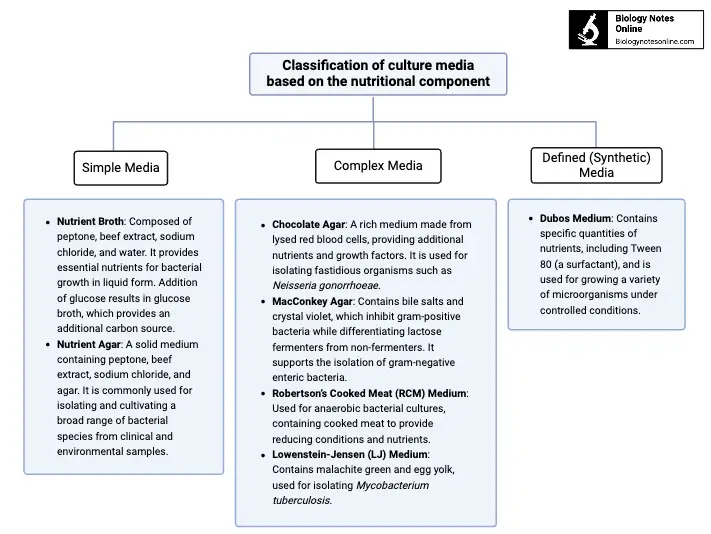
Simple Media
The simplest media serve as the fundamental nutrient source for all sorts of microbes.
They meet your basic requirements without requiring any additional complex ingredients.
- Composition -This includes a carbon source, nitrogen compounds, salts, and water. Enrichment is not needed.
- Applications – Used in performing quotidian lab procedures and cultivating non-fussy organisms that don’t demand fastidious attention.
- Examples:
- Nutrient Broth– Peptone, beef extract, NaCl and water (plus peptone sugar) make up nutrient broth which can be seen as glucose broth by virtue of the addition of glucose.
- Nutrient Agar– Nutrient broth in solid form, plus agar, supports a wide range of microbial isolates
Complex Media
Containing ingredients with variable, frequently undefined compositions, complex media are the good choice for more fastidious organisms. These mixtures often contain extracts from organic origins.
- Composition -Roughly derived from tissues of animal or plant, providing amino acids, vitamins and other growth factors.
- Applications– Used to cultivate bacteria, both those that are “fastidious” as well as others for experiment and clinical work.
- Examples:
- Chocolate Agar-Enriched with lysed red blood cells to grow fastidious organisms such as Neisseria gonorrhoeae.
- MacConkey Agar -Containing bile salts and crystal violet, it inhibits gram-positive bacteria but can show who is consuming lactose on lactose turn to acid and what color turns up there under the microscope (both blue-purple being typical). (Editor’s note—lose backward comma.)
- Robertson’s Cooked Meat Medium – Used to harvest anaerobes, it is designed to produce reduced conditions directly from meat—for these organisms living without oxygen is life itself.
- Lowenstein-Jensen Medium– Made with malachite green and egg yold for isolating Mycobacterium tuberculosis.
Defined (Synthetic) Media
Defined media are built from ingredients that are measured precisely, so as to provide complete control over the nutrient composition. They contain no biological extracts.
- Composition– They will often include inorganic salts present at specific concentrations, a known carbon source like glucose, nitrogen compounds (usually ammonium salts), vitamins and trace metals.
- Applications – When research requires strict control over nutrients—metabolic studies especially.
- Examples:
- Dubos Medium– A series of controlled experiments to find what constituents promote growth in these circumstances, all nutrients balanced including Tween 80.
Classification of culture media based on functional use or application
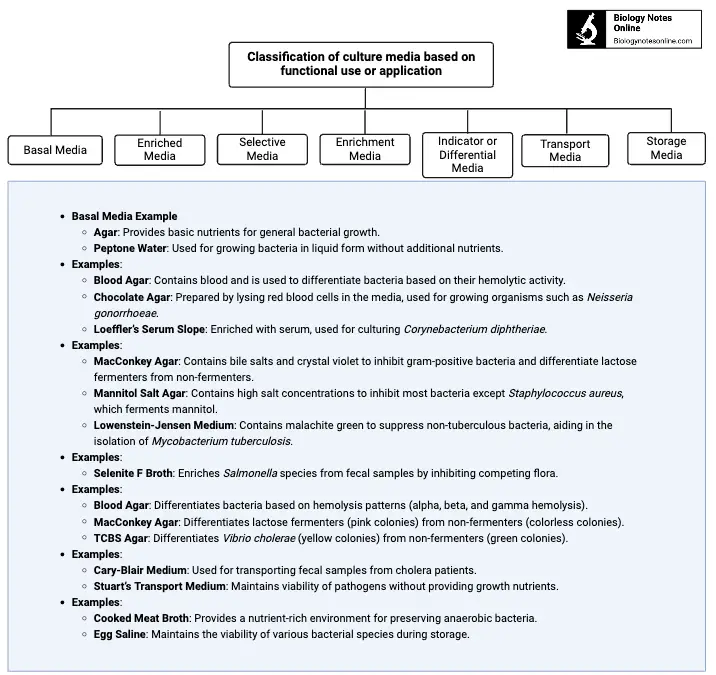
According to their functional use or specific application, culture media can be classified in different ways, with each type dedicated to different purposes in the procedures for cultivation of microorganisms. These media vary considerably in both composition and function as they play a role in facilitating bacterial growth or isolation.
1. Basal Media
The media are basic, non-selective, and designed for the cultivation of a wide variety of microorganisms. Their composition is primarily that of basic carbon and nitrogen sources which are essential for bacterial growth. They need no added substances to promote microbial development at all. In virology they are mostly employed in maintenance culturing and sub-culturing, where there is no great emphasis on selecting particular microorganisms, but rather merely in keeping general microbial populations afloat. Examples include nutrient agar and peptone water, which provide the smallest number of nutritional ingredients necessary to support non-fastidious bacterial growth.
2. Enriched Media
Enriched media are more complex, and made by adding additional growth factors such as blood, serum, or egg yolk. This enables fastidious organisms to be grown which require specific nutrients in order to grow optimally. Often these media will inhibit the growth of non-target organisms so that only the desired bacteria might thrive. For instance, blood agar will classify bacteria on the basis of their haemolytic activity, whilst chocolate agar, made realistically by lysing red blood cells to form a distinct nutritional substrate, is used in culturing Neisseria gonorrhoeae. These media are essential when it comes to isolating and recognising species of micro-organisms that will not grow in the basic media.
3. Selective Media
Way is tailored to facilitate and favour the growth and development of certain microorganisms while preventing others from increasing. This selectivity can be created with the aid of agents like antibiotics, bile salts, or dyes. McConkey agar, for example, prevents Gram-positive bacteria while allowing growth of Gram-negative ones, and is also used to differentiate between lactose fermenters and non-fermenters. Similarly mannitol salt agar contains a high concentration of salt, which hinders the growth of many bacteria but not Staphylococcus aureus, which in fact ferments mannitol. Selective media are indispensible when attempting to segregate particular pathogens from a mixed microbial population.
4. Enrichment Media
But unlike selective media that inhibits all kinds of undesired growth at the same time, enrichment media serve to concentrate specific strains of microorganisms. Such media promote the growth of chosen microorganisms and inhibit all other competing ones. Used in environmental and clinical testing of samples, selenite F broth is a good illustration: as content for feces, it promotes the growth of types Salmonella while preventing other bacteria from flourishing. This type of medium proves particularly useful when the sought-after microorganism is very scarce.
5. Indicator or Differential Media
Indicator or differential media permit the differentiation of bacterial species in line with their characteristic metabolic activities. By including special chemicals or substrates, these media change their colour according to the kind of biochemical reactions that occur in microbial life. As an example, MacConkey agar separates lactose fed bacteria (which create pink colonies) from those that don’t ferment chlorine in order for water usage to shift from one valency state of chloride twice. It separates Vibrio cholerae on the grounds that a yellowy-colour substrate is formed due to sucrose fermenting colonies, as seen in the case of TCBS agar.
6. Transport Media
Transport media are necessary for the preservation of microorganisms from the time they are first collected until they reach a laboratory. Without nutrients of any kind, these media prevent growth but keep microbes alive. Cary-Blair medium is used to send samples of faeces from cholera patients, and Stuart’s transport medium often used for one kind clinical pathogens.
7. Storage Media
Storage media are needed to preserve bacterial cultures for long periods of time. These media are designed to assist the survival of microorganisms even over months or years, many times by their inclusion with substances which can protect against freezing or dehydration. Through the action of substances like meat broth and its high nutrient content protect anaerobic bacteria, Cooked meat broth proves an appropriate medium for the preservation of one such example. Egg saline is another medium that can be employed to store a variety of bacterial species.endforeach
Classification of culture media based on oxygen requirement
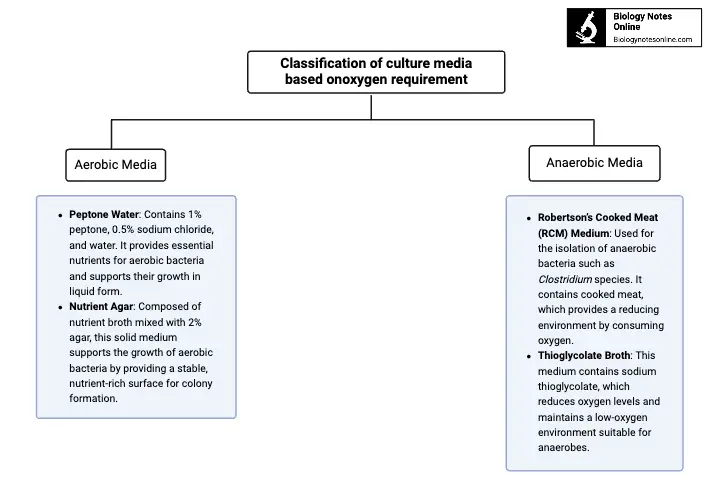
Culture media can be grouped by the oxygen needs associated with microorganisms meant to be supported. This division includes aerobic and anaerobic media, each of which has different characteristics to meet the needs of distinct bacteria.
1. Aerobic Media
As the name implies, aerobic media are meant for microorganisms that depend on oxygen for growth. These media provide an environment rich in oxygen, perfect for aerobic bacteria and facultative anaerobes, which can survive under either low levels or high-oxygen conditions
Aerobic media normally consists of essential nutrients to keep bacteria growing.
They are often prepared in both solid and liquid forms. Peptone Water, for example, is a simple liquid medium with peptone and sodium chloride (salt) added.
It serves as a basis to nourish aerobic microorganisms. On the other hand, Nutrient Agar, consisting of nutrient broth as well as agar, creates a solid surface for the cultivation of pure aerobic cultures. The paramount thing here is that oxygen is always available, making them suitable for organisms which need it for metabolic processes.
2. Anaerobic Media
On the other hand, anaerobic media is designed for microorganisms that live in low-oxygen or completely oxygen-free environments. These media are usually rich with nutrients obtained from the environment and, in addition, include agents to balance oxidation-reduction potential: they thus create anaerobic environments.
Anaerobic media are particularly important for cultivating bacteria that cannot tolerate oxygen and would die in aerobic conditions. These media often include chemicals to eliminate oxygen from them, such as sodium thioglyco-late, or boiling to drive off the air. Robertson’s Cooked Meat (RCM) Medium is a typical example; it is used mainly to cultivate anaerobes like Clostridium spp. The meat in this medium serves to remove oxygen from the solution, thereby providing an environment most suitably anaerobic. Thioglycolate Broth is another; containing sodium thioglycolate, it effectively keeps out oxygen and is designed to create anaerobic conditions, providing a hospitable environment for anaerobes to thrive.
Classification of culture media based on special purpose
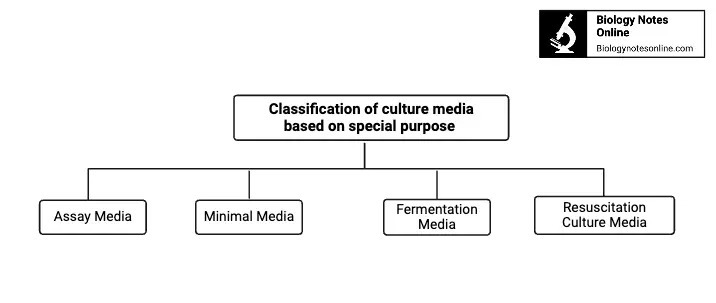
Culture media with special purposes are key tools in researching micro-organisms. They reflect the unique characteristics of microorganisms and can meet their various needs. This includes media. In metabolism work they help to identify those metabolic features which are uniquely human; it is possible they perform a similar function in bacteria. They plant the seeds of future microbial growth, too fermentation or genetic studies. Let’s have a look at the different kinds of special purpose culture media and their applications.
1. Assay Media
Assay media are used to test the activity of various substances, such as antibiotics, vitamins, and amino acids. Media of this sort are indispensable for testing which dosages will work best in practice, and play an important role in evaluating resistance in micro-organisms. For example, the Mueller?Hinton agar is often employed as a medium for antibiotic sensitivity tests. Its tiny pores, which let out 1.7% agar from the gel, allow the antibiotic to diffuse throughout this in 小ciently large area over several hours. The starch in it absorbs toxins produced by bacteria-resulting in a large clear area around the antibiotic disc, denoting that it works well to 9殳hibit bacterial growth. Such tests are vital in clinical practice now for selecting effective treatments against infections.
2. Minimal Media
Minimal media are those with a precise composition that supplies only the essential nutrients required for a specific micro-organism’s growth.*1 These media are especially useful in genetic studies. Quite often they are used to compare how well wild-type strains grow in comparison with mutants. These key ingredients include a carbon source, such as sugar or succinate, and inorganic salts like magnesium, nitrogen and phosphorus. Minimal media help to identify microbial strains that require specific nutrients or conditions for growth. Further, they are used in the selection of recombinant strains-central to research in molecular biology and genetics.
3. Fermentation Media
To nourish microorganisms that are involved in the achievement of fermentation processes, fermentation media are key for increasing yields of fermentation products. This media provides the energy and ingredients necessary for microbial growth and product synthesis, both long-term and short-term. It will usually contain major components such as the carbon source and nitrogen sources, minor components plus such things as vitamins, buffers and growth factors. Fermentation media can range from low-nutrient to sustain microbe growth to rich in extra nutrients for metabolic products. For example, yeast extract peptone dextrose (YPD) or buffered glycerol mineral medium (BMGY)*flowers may both be used to increase metabolic activity and produce more fermentation than can be done economically in industry.
4. Resuscitation Culture Media
Resuscitation media are designed to rejuvenate bacterial cells that have become stressed or damaged from environmental abuse out of all normal metabolic functions. They provide the nutrients needed to restore these cells. One of many examples is tryptic soy agar (TSA). It is helpful in the pro.GetMapping On With It.Unicode of bacteria that may require specific ingredients, e.g. histamine, for their growth. When bacteria fail to grow on ordinary media due to lack of nutrients or environmental stress, resuscitation media offer just the right mix of ingredients to push them into growth again and overcome stress.
Why do bacteria have to be grown (cultured) in the laboratory on artificial culture media?
- It is the detection of infected diseases that gives us one of its most important uses. The process can produce organisms from points that are normally germ-free, and these are then used to indicate how the disease develops. Indeed, being able to extract an organism from a clinical sample may prove crucial evidence of its role as an etiologic agent.
- Culturing bacteria is an important first step in observing its morphology as well as recognizing it.
- Antigens are obtained for serological tests or vaccines by culturing bacteria.
- Some genetic studies and manipulation of cells need that bacteria be grown in the laboratory, too.
- When bacteria are grown in culture vessels and the density has reached its maximum, this may be a correct method to detect living bacteria.
- When laid on solid surfaces, the growth of bacteria also provides a useful means for separating them from mixtures.
Application of Culture Media
Here’s a detailed look at the various functions and applications of culture media:
- Microbial Cultivation serves a crucial role in supporting life forms necessary for research, diagnostics, and industry. These medium give bacteria with the essential nutrients and appropriate environmental conditions. Without such substrates, raising and researching microorganisms would be impossible. The capacity to spread microbial strains—whether bacteria, fungi, or viruses—remains crucial in scientific development.
- Pathogen Identification and Disease Diagnosis are among the most significant applications. In clinical contexts, culture medium assist isolate pathogenic germs from patient samples, making it feasible to identify the exact pathogen causing an infection. This exact separation allows accurate diagnosis, which is crucial in determining the most appropriate therapy. With the correct medium, finding hard-to-culture infections becomes easier, directly impacting patient outcomes.
- When it comes to Antimicrobial Susceptibility Testing, different formulations of culture medium help to assess the efficacy of antimicrobial drugs. By analysing how diverse infections react to antibiotics, physicians may adapt treatments more successfully. This use is helpful not only in the medical area but also in the creation of novel antimicrobial medications, as media permit testing under controlled settings.
- Another key area is the Study of Microbial Growth and Metabolism. Researchers regularly utilise culture medium to examine the growth patterns, biochemical responses, and metabolic activities of bacteria. These regulated circumstances enable for exact measurements of enzyme activity and the synthesis of metabolites. Insights gathered from these investigations have ramifications for everything from environmental science to medications.
- In the realm of Biotechnology, specific media are crucial for growing microorganisms that create useful commercial products. Antibiotics, enzymes, and biofuels are just a few examples of substances made from cultivated bacteria. Biotechnologists rely on these medium to create compounds at an industrial scale, driving forward medicinal and environmental advances.
- The role of culture medium goes beyond labs and into Environmental Microbial Monitoring. Media used in environmental testing assist measure microbial populations in water, soil, and air. This application is vital for monitoring pollution levels, facilitating ecological investigations, and helping to environmental conservation initiatives.
- Food and Pharmaceutical Safety rely primarily on the identification of microorganisms in consumer items. Culture media assist discover any microbial contamination that might offer health hazards. From assuring the safety of food goods to ensuring pharmaceutical formulations are free from hazardous organisms, this application is vital to safeguarding public health.
- Infection Diagnosis needs accuracy, and culture medium give the means for microbiologists to identify microorganisms responsible for diseases. By cultivating microorganisms from patient samples, reliable pathogen identification leads to focused treatment techniques, boosting patient recovery rates.
- Microbial Characterization using culture medium allows researchers to examine microbial strains in depth, identifying variations in biochemical responses and colony form. This helps identify one species from another, providing depth to our understanding of microbial diversity.
- To obtain pure research, Isolation and Purification are crucial. Culture medium enable scientists to isolate single microbe strains, which are important for extensive research and studies. Without clean cultures, the veracity of many study findings would be undermined.
- Culture Stock Maintenance is another essential use. Storing microbial strains under ideal conditions assures their availability for future study or industrial usage. It also assists in conserving uncommon or important strains for long-term initiatives.
- Culture medium also play a vital part in Biochemical Reaction Observation. They allow researchers to analyse the chemical changes microorganisms undergo throughout metabolic activities. These discoveries are vital for applications in medical and environmental research.
- In Contamination Testing, culture medium are used to detect undesirable microorganisms in goods and settings. Ensuring the purity of medications, foods, and industrial items is crucial to prevent deterioration and assure safety.
- In the field of antibacterial and Preservative Testing, culture medium are crucial instruments for measuring the efficiency of preservatives and antibacterial agents. This testing is basic for creating items that require lengthy shelf life, such as cosmetics, food, and medications.
- Colony Analysis done on culture medium enables microbiologists to observe microbial colonies in varied conditions. The form, colour, and development patterns of colonies are vital for identifying microbial species, offering a starting point for future study or therapy.
- In Antigen Production, culture medium are used to cultivate microorganisms that create antigens for diagnostic reasons. These antigens are important for laboratory studies, notably in the identification of illnesses or in vaccine production.
- Viable Count Estimation is another fundamental usage of cultural media. By counting the live microorganisms in a sample, researchers can measure microbial contamination levels. This is significant in clinical diagnosis, environmental monitoring, and food safety.
- Finally, Antibiotic Sensitivity Testing offers the foundation for understanding how effectively antibiotics will act against certain microbial strains. It helps practitioners pick the proper antibiotic, guaranteeing both effectiveness and the minimisation of resistance development.
Limitations of culture media
- The potential of cross-contamination comes out as a key problem. Microbial species can accidentally contaminate the media, providing erroneous findings. This contamination jeopardises both research and diagnosis, making it harder to identify organisms appropriately. Sometimes, a single mismanagement of the media might unleash a cascade of failures.
- Another restriction is the high expertise necessary for effective media preparation and use. If one lacks experience, it might result in inappropriate inoculation or wrong storage, which leads to suboptimal growing circumstances for the bacteria. The repercussions are clear: trials could not be trustworthy, and the results could be biassed, confounding study aims.
- When media dry out, they lose their vibrancy. Without adequate storage, the nutrients therein can deteriorate, compromising the viability of the bacteria being grown. The variations in composition can lead to the failure of studies, as microbial growth may either stall or be inefficient. This is a subtle but important lab technician problem.
- In addition, not all culture medium are sufficiently selective or specific for every species of microbe. This constraint complicates the separation of some microorganisms, especially those that need highly specialised growing settings. Without the correct circumstances, certain bacteria or fungus simply cannot survive, narrowing the breadth of what may be investigated or identified.
- The resurrection of injured microorganisms is another challenge. Media are often inefficient at recovering microorganisms that are stressed or non-viable. This provides a big challenge in investigating specific bacteria that have been damaged. Whether injured by environmental conditions or non-cultivable by nature, such bacteria frequently cannot be brought back to life using normal medium.
- Incompatibility with some bacteria is also worth noting. For instance, viruses, certain fungi, or archaea require live tissues or harsh environmental conditions to flourish, something that culture medium cannot give. This creates a gap in their value, restricting researchers’ capacity to examine a larger spectrum of microorganisms.
- The time-consuming aspect of culturing microorganisms also must be overlooked. The process sometimes spans days or even weeks before observable development is evident. For speedy diagnostics or quick outcomes, this delay becomes a drawback, requiring researchers to seek alternatives when time is of the importance.
- Lastly, vulnerability to contamination is a continuing challenge. Despite strict safeguards, media can still be corrupted, resulting to distorted findings. Ensuring sterility needs considerable effort, as a breach might invalidate whole research. Without sufficient protections, the possibility of contamination can drastically limit the results of any microbiological investigation.
Example of common Culture Media with their functions
- Nutrient Agar– Simple but effective, Nutrient Agar supports the development of many non-fibrous microorganisms. It provides nutrients from beef extract, peptone, and agar. This medium is commonly used in labs to cultivate and isolate various microorganisms.
- MacConkey Agar– Identifying lactose fermenters and non-fermenters, this selective medium isolates Gram-negative bacteria. With bile salts, crystal violet, neutral red, and lactose, it is useful in clinical and environmental microbiology for isolating Enterobacteriaceae.
- Blood Agar – This red blood cell-rich media supports bacteria growth and hemolysis patterns. To grow fastidious organisms, its enriched nature is ideal. The capacity to lyse red blood cells helps distinguish germs.
- Eosin Methylene Blue (EMB) Agar – Isolating Gram-negative bacteria, especially enteric ones, requires this technology. To emphasize lactose fermentation, EMB Agar utilizes eosin Y and methylene blue dyes. Escherichia coli colonies commonly change color. The identification of enteric bacteria depends on this medium.
- Sabouraud Dextrose Agar– Sabouraud Dextrose Agar includes dextrose and peptone for maximum fungal and yeast development. It is vital for mycological diagnosis and mold and dermatophyte studies.
- Cetrimide-Agar – Cetrimide agar isolates Pseudomonas aeruginosa by inhibiting bacterial growth. Pseudomonas identification is crucial in clinical diagnosis.
- Xylose Lysine Deoxycholate (XLD) Agar– Lysine Deoxycholate (XLD) XLD Agar is a selective and differential medium for isolating Gram-negative enteric bacteria. Based on fermentation patterns, Salmonella and Shigella react differently. This medium detects intestinal pathogens often.
- Thayer-Martin Agar– The enhanced and selective Thayer-Martin Agar medium isolates Neisseria gonorrhoeae and meningitidis. Vancomycin and colistin suppress competing flora, making it useful for identifying Neisseria infections.
- Mrs. MRS Agar– MRS Agar grows lactic acid bacteria using glucose and yeast extract. The media for probiotic and fermentation investigations using lactic acid bacteria is essential.
- Luria-Bertani (LB) Agar – Most commonly used to grow Escherichia coli, LB Agar is essential for bacterial cloning and gene expression investigations. It provides tryptone, yeast extract, and sodium chloride for strong bacterial growth.
- Mannitol Salt Agar (MSA)– The Mannitol Salt Agar (MSA) medium is used to identify and distinguish Staphylococcus species, notably Staphylococcus aureus. Due to its high salt content and mannitol, MSA helps identify fermenters by phenol red.
- Bile Esculin Agar– Enterococci and Streptococcus are isolated in this selective medium. A key property of enterococci is their capacity to hydrolyze esculin, which is determined by bile salts and esculin.
- BCA yeast extract Agar – BCYE Agar isolates Legionella species with specific enrichment. The charcoal and yeast extract reduce contaminating bacteria and allow Legionella pneumophila to grow.
- Potato Dextrose Agar (PDA)– PDA is a nutrient-rich medium produced from potato infusion and dextrose, suitable for growing molds and yeasts. It is frequently used in mycological diagnostics and research, especially for fungal growth investigation.
- Rich Medium (R2A) -R2A Agar, nutrient-rich, grows slow-growing, nutrient-poor environmental bacteria from water and soil samples. A low nutrient concentration helps stressed bacteria flourish.
- Kligler Iron Agar (KIA) -KIA is a vital medium for detecting Gram-negative enteric bacteria by fermentation patterns and hydrogen sulfide generation. Enterobacteriaceae’s metabolism is shown by its glucose, lactose, iron salts, and phenol red.
- LYE Agar – These selective mediums isolate and count lactose-fermenting bacteria. This yeast extract, lactose, and agar mixture is used in dairy products to research lactose fermentation.
- Czapek-Dox Agar – Czapek-Dox Agar, which grows Aspergillus and Penicillium, uses just sodium nitrate. Fungal metabolism and resource use species differentiation are possible in this minimum media.
- Hektoen Enterisch Agar– HE Agar selectively isolates Salmonella and Shigella. It differentiates by carbohydrate fermentation and hydrogen sulfide generation with bile salts, bromthymol blue, and acid fuchsin.
- The Nutrient Broth– A general-purpose liquid media, Nutrient Broth enables liquid culture bacterial growth. Its versatility makes it necessary for ordinary microbiological work, including subculturing, bacterial growth assays, and diverse experimental circumstances.
| Culture Media | Function | Composition | Application |
|---|---|---|---|
| Nutrient Agar | General-purpose medium for a wide range of bacteria. | Beef extract, peptone, agar | Routine microbial cultivation and isolation. |
| MacConkey Agar | Selective and differential medium for Gram-negative bacteria; differentiates lactose fermenters. | Bile salts, crystal violet, neutral red, lactose | Isolating Enterobacteriaceae and detecting lactose fermentation. |
| Blood Agar | Enriched medium for a variety of bacteria; allows observation of hemolysis patterns. | Red blood cells, nutrient-rich components | Growing fastidious organisms and hemolysis testing. |
| Eosin Methylene Blue (EMB) Agar | Selective and differential medium for Gram-negative bacteria; differentiates lactose fermenters. | Eosin Y, methylene blue | Identifying Escherichia coli and other enteric bacteria. |
| Sabouraud Dextrose Agar | Enriched medium for fungi and yeasts. | Dextrose, peptone | Cultivating dermatophytes, yeasts, and molds. |
| Cetrimide Agar | Selective medium for isolating Pseudomonas aeruginosa. | Cetrimide | Identifying Pseudomonas aeruginosa in clinical and environmental samples. |
| Xylose Lysine Deoxycholate (XLD) Agar | Selective and differential medium for enteric bacteria; differentiates based on fermentation patterns. | Xylose, lysine, sodium thiosulfate, phenol red | Detection and differentiation of Salmonella and other enteric pathogens. |
| Thayer-Martin Agar | Enriched and selective medium for Neisseria species. | Antibiotics (vancomycin, colistin, nystatin) | Isolating Neisseria gonorrhoeae and Neisseria meningitidis. |
| Potato Dextrose Agar (PDA) | Enriched medium for fungi and yeasts. | Potato infusion, dextrose | Cultivating molds and yeasts, used in mycological research. |
| Rich Medium (R2A Agar) | Nutrient-rich medium for slow-growing and nutrient-poor bacteria. | Low concentrations of nutrients, organic compounds | Cultivating stressed or slow-growing bacteria from environmental samples. |
| Kligler Iron Agar (KIA) | Differential medium for enteric bacteria based on carbohydrate fermentation and hydrogen sulfide production. | Glucose, lactose, iron salts, phenol red | Differentiating Enterobacteriaceae based on metabolic activities. |
| Mannitol Salt Agar (MSA) | Selective and differential medium for Staphylococcus species; identifies mannitol fermenters. | Sodium chloride, mannitol, phenol red | Identifying Staphylococcus aureus and differentiating it from other Staphylococcus species. |
| Bile Esculin Agar | Selective medium for enterococci and group D Streptococcus species; differentiates based on esculin hydrolysis. | Bile salts, esculin | Differentiating enterococci from other Gram-positive cocci. |
| Buffered Charcoal Yeast Extract (BCYE) Agar | Enriched medium for isolating Legionella species. | Charcoal, yeast extract, antibiotics | Cultivating Legionella pneumophila, important for diagnosing Legionnaires’ disease. |
| Potato Dextrose Agar (PDA) | Enriched medium for fungi and yeasts. | Potato infusion, dextrose | Supports growth of a wide variety of fungi, including molds and yeasts. |
| Czapek-Dox Agar | Minimal medium for cultivating fungi, especially Aspergillus and Penicillium species. | Sodium nitrate, essential nutrients | Studying the metabolic capabilities of fungi. |
| Lactose Yeast Extract Agar (LYE Agar) | Selective medium for lactose-fermenting bacteria. | Yeast extract, lactose, agar | Studying lactose-fermenting bacteria in various environments. |
| Hektoen Enteric (HE) Agar | Selective and differential medium for enteric Gram-negative pathogens; differentiates based on carbohydrate fermentation and hydrogen sulfide production. | Bile salts, bromthymol blue, acid fuchsin | Isolating and differentiating Salmonella and Shigella. |
| Nutrient Broth | General-purpose liquid medium for bacterial growth. | Peptone, beef extract, sodium chloride | Growing bacteria in liquid culture, subculturing, and testing growth conditions. |
| Mannitol Salt Agar (MSA) | Selective and differential medium for Staphylococcus species; identifies mannitol fermenters. | Sodium chloride, mannitol, phenol red | Identifying Staphylococcus aureus and differentiating it from other Staphylococcus species. |
- https://www.egyankosh.ac.in/bitstream/123456789/10537/1/Experiment-7.pdf
- https://www.researchdive.com/blog/what-are-the-different-types-of-culture-media-used-to-support-microbial-growth
- https://www.slideshare.net/shrekym/types-of-culture-mediapptx-2
- https://medicosage.com/bacterial-culture-media/
- https://www.microrao.com/micronotes/culture_media.pdf
- https://www.teknova.com/resource/types-of-culture-media/
- https://www.brainkart.com/article/Bacteriological-Media-and-its-Types_35235/
- https://www.brainkart.com/article/Types-of-Culture-Media_17850/
- https://www.researchgate.net/figure/Advantages-and-disadvantages-of-semisolid-method_tbl1_267634705
- https://www.ramauniversity.ac.in/online-studymaterial/pharmacy/bpharma/iiisemester/pharmaceuticalmicrobiology/lecture-5.pdf
- https://nios.ac.in/media/documents/dmlt/Microbiology/Lesson-09.pdf
Making everything under culture of microorganisms simple and clear
So understand